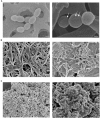Health-Associated Niche Inhabitants as Oral Probiotics: The Case of Streptococcus dentisani
- PMID: 28344574
- PMCID: PMC5344910
- DOI: 10.3389/fmicb.2017.00379
Health-Associated Niche Inhabitants as Oral Probiotics: The Case of Streptococcus dentisani
Abstract
Oral diseases, including dental caries and periodontitis, are among the most prevalent diseases worldwide and develop as a consequence of a microbial dysbiosis. Several bacterial strains are being tested as potential oral health-promoting organisms, but usually they are species isolated from niches other than the site where they must exert its probiotic action, typically from fecal samples. We hypothesize that oral inhabitants associated to health conditions will be more effective than traditional, gut-associated probiotic species in key aspects such as colonization of the oral site where disease takes place or the possession of oral health promoting functions, as well as more practical issues like safety and toxicity, and establishing proper doses for administration. As an example of these active colonizers, we describe the case of Streptococcus dentisani, a new streptococcal species isolated from dental plaque of caries-free individuals. We have detected it in 98% of dental plaque samples from healthy individuals and, as expected, it does not produce any toxic secondary metabolite and does not survive a simulated stomach digestion, preventing potential secondary effects. Besides, this species has a double probiotic action, as it inhibits the growth of major oral pathogens through the production of bacteriocins, and also buffers acidic pH (the primary cause of dental caries) through an arginolytic pathway. We propose the use of S. dentisani as a promising probiotic against tooth decay.
Keywords: Streptococcus dentisani; arginolytic pathway; bacteriocins; dental caries; pH buffering; probiotics.
Figures





Comment in
-
Commentary: Health-Associated Niche Inhabitants as Oral Probiotics: The Case of Streptococcus dentisani.Front Microbiol. 2018 Feb 27;9:340. doi: 10.3389/fmicb.2018.00340. eCollection 2018. Front Microbiol. 2018. PMID: 29535701 Free PMC article. No abstract available.
References
LinkOut - more resources
Full Text Sources
Other Literature Sources
Molecular Biology Databases
Research Materials

